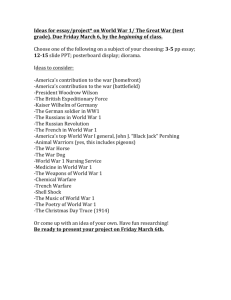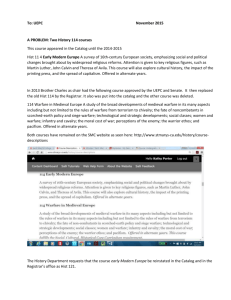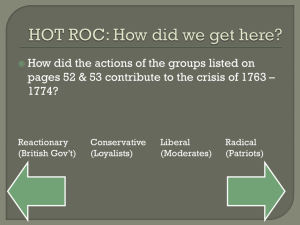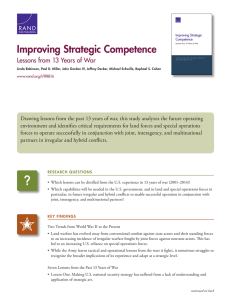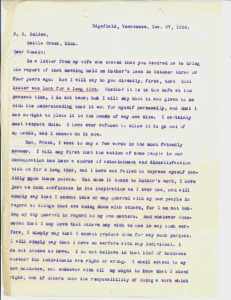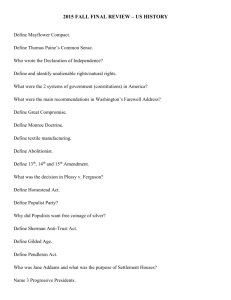Special Warfare
advertisement
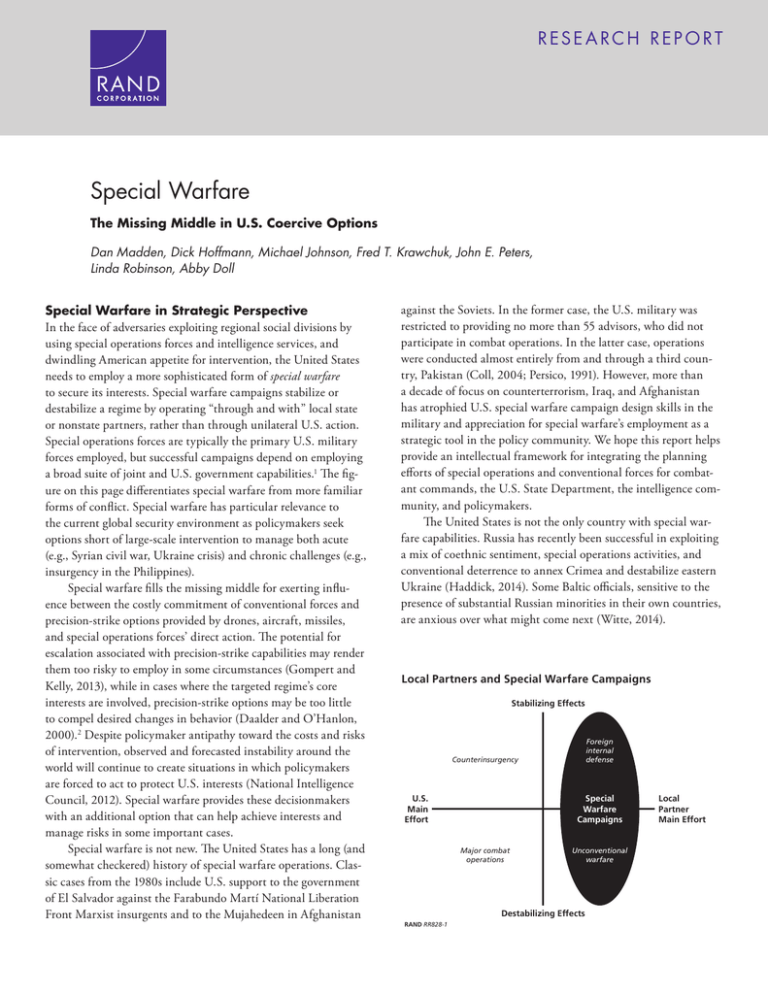
RESE ARCH REPO RT C O R P O R AT I O N Special Warfare The Missing Middle in U.S. Coercive Options Dan Madden, Dick Hoffmann, Michael Johnson, Fred T. Krawchuk, John E. Peters, Linda Robinson, Abby Doll Special Warfare in Strategic Perspective In the face of adversaries exploiting regional social divisions by using special operations forces and intelligence services, and dwindling American appetite for intervention, the United States needs to employ a more sophisticated form of special warfare to secure its interests. Special warfare campaigns stabilize or destabilize a regime by operating “through and with” local state or nonstate partners, rather than through unilateral U.S. action. Special operations forces are typically the primary U.S. military forces employed, but successful campaigns depend on employing a broad suite of joint and U.S. government capabilities.1 The figure on this page differentiates special warfare from more familiar forms of conflict. Special warfare has particular relevance to the current global security environment as policymakers seek options short of large-scale intervention to manage both acute (e.g., Syrian civil war, Ukraine crisis) and chronic challenges (e.g., insurgency in the Philippines). Special warfare fills the missing middle for exerting influence between the costly commitment of conventional forces and precision-strike options provided by drones, aircraft, missiles, and special operations forces’ direct action. The potential for escalation associated with precision-strike capabilities may render them too risky to employ in some circumstances (Gompert and Kelly, 2013), while in cases where the targeted regime’s core interests are involved, precision-strike options may be too little to compel desired changes in behavior (Daalder and O’Hanlon, 2000).2 Despite policymaker antipathy toward the costs and risks of intervention, observed and forecasted instability around the world will continue to create situations in which policymakers are forced to act to protect U.S. interests (National Intelligence Council, 2012). Special warfare provides these decisionmakers with an additional option that can help achieve interests and manage risks in some important cases. Special warfare is not new. The United States has a long (and somewhat checkered) history of special warfare operations. Classic cases from the 1980s include U.S. support to the government of El Salvador against the Farabundo Martí National Liberation Front Marxist insurgents and to the Mujahedeen in Afghanistan against the Soviets. In the former case, the U.S. military was restricted to providing no more than 55 advisors, who did not participate in combat operations. In the latter case, operations were conducted almost entirely from and through a third country, Pakistan (Coll, 2004; Persico, 1991). However, more than a decade of focus on counterterrorism, Iraq, and Afghanistan has atrophied U.S. special warfare campaign design skills in the military and appreciation for special warfare’s employment as a strategic tool in the policy community. We hope this report helps provide an intellectual framework for integrating the planning efforts of special operations and conventional forces for combatant commands, the U.S. State Department, the intelligence community, and policymakers. The United States is not the only country with special warfare capabilities. Russia has recently been successful in exploiting a mix of coethnic sentiment, special operations activities, and conventional deterrence to annex Crimea and destabilize eastern Ukraine (Haddick, 2014). Some Baltic officials, sensitive to the presence of substantial Russian minorities in their own countries, are anxious over what might come next (Witte, 2014). Local Partners and Special Warfare Campaigns Stabilizing Effects Foreign internal defense Counterinsurgency Special Warfare Campaigns U.S. Main Effort Major combat operations Unconventional warfare Destabilizing Effects RAND RR828-1 Local Partner Main Effort –2– Coupled with its quest for nuclear capability, Iran risks a cascading proliferation of nuclear weapons in a deeply divided region. Iran has skillfully employed its own special warfare capabilities as part of a long-term regional strategy, using state and nonstate proxies to advance its regional interests (Crist, 2012; Thomas and Dougherty, 2013). Iran’s actions in Syria, for example, have contributed to a vexing dilemma for the United States, in which both action and inaction threaten policy disaster—the former an Iraq-style quagmire and the latter an uncontrolled regionalization of Sunni-Shi’a sectarian conflict. The Syria dilemma is symptomatic of Iran’s broader efforts to establish a sphere of influence in the Middle East through mechanisms that ingrain instability in the structure of sectarian interrelations, exemplified by Iran’s patronage of clients such as Hezbollah and its Quds Force activities in Iraq and other Arab states. Coupled with its quest for nuclear capability, Iran risks a cascading proliferation of nuclear weapons in a deeply divided region. In the longer term, if Iran’s quest for and Russia’s exercise of nuclear deterrence and irregular influence are seen as successful asymmetric strategies for circumventing U.S. conventional dominance, other regional or aspiring global powers might adopt similar approaches to securing their interests. The United States should consider employing special warfare campaigns to counter the aggressive employment of proxies by states competing for regional influence. Though there is no obligation for the United States to fight its adversaries symmetrically, adversaries are challenging the nation in ways difficult to credibly deter with conventional campaigns or precision strikes alone (Mueller, Martini, and Hamilton, 2013). If the United States were to rebalance its dependence on precision-strike, conventional, and special warfare capabilities, and how they are used to complement one another, it might constitute a change in strategic posture analogous to the shift from Eisenhower’s New Look dependence on massive nuclear retaliation for deterrence to Kennedy’s Flexible Response goal of deterring aggression at multiple levels of the escalation ladder (Morgan et al., 2008). Our findings and recommendations are based on semistructured interviews with special warfare practitioners and researchers, observed military exercises, a review of relevant literature, country and theater campaign plans, case studies, and analysis of a data set of special warfare operations that our team constructed for this study (see Madden et al., forthcoming). Characteristics of Special Warfare Special warfare campaigns, properly conducted, are far more than an activity for special operations forces. They involve the comprehensive orchestration of U.S. government capabilities to advance policy objectives. Special warfare campaigns have six central features: • Their goal is stabilizing or destabilizing the targeted regime.3 • Local partners provide the main effort. • U.S. forces maintain a small (or no) footprint in the country. • They are typically of long duration and may require extensive preparatory work better measured in months (or years) than days. • They require intensive interagency cooperation; the Department of Defense (DoD) may be subordinate to the Department of State or Central Intelligence Agency (CIA).4 • They employ “political warfare” methods to mobilize, neutralize, or integrate individuals or groups from the tactical to strategic levels. The term political warfare has fallen out of fashion since the end of the Cold War, and so bears some explanation. George Kennan defined it in 1948 as “all the means at a nation’s command, short of war, to achieve its national objectives” (quoted in Rudgers, 2000), though perhaps it should be read as “short of conventional or nuclear war.” In many ways, the concept of political warfare fits within Joseph S. Nye’s concept of “smart power” (Nye, 2011). Activities range from influence operations and political action to economic sanctions and coercive diplomacy. These definitions and examples are so broad as to be near all-encompassing, but a defining feature of these activities is their influence on the political coalitions that sustain or challenge power. Political warfare might be thought of as the art of making or breaking coalitions. Historically, U.S. special operations forces have found their comparative advantage in political warfare at the tactical level (retail politics), while other government agencies have found theirs at the strategic level. It is the political warfare element of special warfare campaigns that requires intensive interagency collaboration, creating situations where the joint force may be supporting an effort led by the State Department or CIA. Strategic Advantages Some advantages of special warfare include: • Improved understanding and shaping of the environment. Special warfare, executed through intelligence or select military activities, can improve U.S. contextual understanding of potential partners and the situation on the ground before the United States commits to a course of action. In the longer term, special warfare also expands the community of U.S. government experts on an area of interest. As the operating environment is better understood, the United States can engage stakeholders, assess their compatibility with U.S. interests, and selectively augment their capacity. What the special operations forces community refers to as preparation of the environment activities are thought by special warfare practitioners to be key to achieving these effects (Mazzetti, 2013).5 –3– • Cost-imposing strategies. Special warfare’s small-footprint approach allows the United States to pursue cost-effective, cost-imposing strategies, forcing opponents to spend disproportionate amounts to defend against friendly capabilities. The United States has been on the wrong end of the cost exchange equation in recent years (e.g., counterinsurgency to deny al Qaeda sanctuary and the air-sea battle to counter anti-access/area-denial threats), and special warfare can help reverse this. • Managed escalation and credibility risk. Given a decision to intervene, policymakers could use special warfare to avoid making commitments beyond U.S. interests. However, decisionmakers must carefully assess the escalation criteria and the options of adversaries and their external partners. Assessing the adversary’s (and America’s own) likely escalation behavior is fraught with uncertainty, not least because adversaries may not understand how their own preferences may change as the situation evolves (e.g., jingoistic pressure from domestic constituencies).6 • Sustainable solutions. Sustainability has two components: fiscal and political. Special warfare’s small-footprint approach can be more fiscally and politically sustainable than alternatives when underlying sources of conflict cannot be resolved in the short term, preserving core U.S. interests at costs that the nation is willing to bear. From a host nation or coalition political perspective, commanders can also use special warfare’s partner-centric approach to design campaigns around a partner’s core interests, rather than hoping to transform them in ways that have frequently proven to be ephemeral. Limits and Risks As noted earlier, special warfare campaigns are characterized by operations in which the local partner provides the main effort. This dependency on partners carries a set of risks and limitations, as do other characteristics of special warfare. These include: • Divergent partner objectives. A U.S. partner may have core objectives that conflict with those of the United States, or the partner may simply prioritize them differently. Assessments before and during campaigns are necessary to ensure that the partnership is still an appropriate vehicle for advancing U.S. policy goals. U.S. policymakers need to be prepared to terminate efforts if partner objectives diverge too much from U.S. objectives. This is much easier to do in a special warfare campaign than a conventional one. • Ineffective partner capability. The opponent’s level of capability and operational tempo relative to the partner’s may render special warfare solutions ineffective within the required time horizon.7 If U.S. strategic objectives include regime change within a few months, but the prospective partner’s guerrilla capability will require a year to mature, unconventional warfare may be more appropriate as a supporting effort to a conventional campaign, rather than the campaign’s main effort. Appropriate peacetime shaping efforts (e.g., building partner capacity) can help mitigate this risk. • Unacceptable partner behavior. Some partners may behave in ways that transgress America’s normative standards (e.g., respect for human rights) and undermine their own sources of legitimacy. These risks can be mitigated through monitoring, screening, and institutional reform, but they should also be weighed against the policy goals driving the intervention. • Policy fratricide. If special warfare campaigns are not carefully integrated into a holistic U.S. policy toward the targeted country (e.g., through geographic combatant command, country team, and National Security Council staff coordination), U.S. efforts can either turn into direct conflict (e.g., between diplomatic and military lines of effort) or become out of balance. As an example, disproportionate resourcing of military capacity building might undermine longer-term democratization efforts by making the military the only credible institution in a state where the United States is conducing foreign internal defense (e.g., Panama in the 1980s) or in a third country through which it is resourcing an unconventional warfare effort (e.g., growth of Pakistan’s Inter-Services Intelligence during the 1980s). Even if efforts are well integrated to support a unified national policy for the targeted country, the exposure of covert activities might lead to inadvertent escalation with another state or degrade popular perceptions of U.S. respect for national sovereignty among key population segments. • Disclosure. The global proliferation of information technology erodes the ability to keep covert activities covert.8 This proliferation is problematic considering the behavior of prospective covert operators (e.g., on Facebook) and third parties (e.g., Sohaib Athar’s tweets during the raid on Osama bin Laden’s compound, crowd-sourced analysis of YouTube videos in conflict areas) and the capabilities of targeted states (e.g., biometric capabilities). A variety of tactical and technical behaviors and investments can be adopted to mitigate these risks. Even then, unauthorized disclosures (Edward Snowden’s are perhaps the most famous) can place the secrecy of operations at risk. Special warfare campaigns are characterized by operations in which the local partner provides the main effort. This dependency on partners carries a set of risks and limitations, as do other characteristics of special warfare. –4– Though the United States might avoid some of these risks by acting unilaterally, it then loses the strategic advantages identified earlier. Employing Special Warfare Campaigns for Strategic Challenges Consideration of the primary missions of the U.S. armed forces identified in the defense strategic guidance (U.S. Department of Defense, 2012) and the characteristics and history of special warfare led us to identify eight campaign types that might address several current strategic challenges. These campaign types do not exhaust the ways that special warfare can be employed to address these strategic challenges, but we offer them to illustrate scenarios that could be used for contingency and force planning. • Defensive hybrid guerrilla warfare. Deter revisionist states with the prospect of fighting against a protracted insurgency armed with high-end tactical weapons and operational depth. This concept borrows from Hezbollah’s performance in 2006, Russia’s 1994 experience in Grozny (Oliker, 2001), and Switzerland’s and Finland’s Cold War strategies for defense against the Soviet Union (Luttwak, 1980/1981). Related mission: Deter and defeat aggression. • Support to conventional power projection. Employ nonstate actors to disrupt a targeted state’s anti-access/ area-denial capabilities (e.g., Baloch or Kurds in Iran). Related mission: Project power despite anti-access/areadenial challenges. • Support to distant blockade. Degrade a peer competitor’s access to overseas resources on which its economic growth and political stability depend. This might be accomplished by facilitating labor strikes in mining operations, or insurgent interdiction of oil pipelines, in third countries supporting the peer competitor. Related mission: Project power despite anti-access/area-denial challenges. • Covert foreign internal defense for eliminating weapons of mass destruction. When a public relationship of a U.S. partner state is problematic because of the partner state’s domestic politics, covert security force assistance could be directly provided to the partner state to strengthen the security of its weapons of mass destruction assets. Security of these assets could also be improved indirectly by employ- ing unilateral U.S.-sponsored networks. Related mission: Counter weapons of mass destruction. • Counterproliferation against a global network. Interdict and degrade the global proliferation of black markets and front companies (e.g., North Korea’s Office 39).9 If a third country refused to take action against a front company producing nuclear-related industrial equipment, the United States could consider sabotaging equipment in production. Related mission: Counter weapons of mass destruction. • Foreign internal defense in a fractured state. Build governance and security capacity in a state with multiple competing sources of authority and legitimacy (e.g., Somalia, Yemen). Related mission: Conduct stability and counterinsurgency operations. • Building a regional security exporter. Stabilize a partner nation through security and economic assistance in order to enable its regional engagement as a security provider (e.g., operations to counter the Lord’s Resistance Army in Uganda to enable Uganda to deploy its forces to other regional hot spots). Related mission: Provide a stabilizing presence. • Countergenocide unconventional warfare. Organize, train, and equip for self-defense and evasion social groups that are targeted for genocide by the incumbent regime (e.g., Sudan). Related mission: Conduct humanitarian, disaster relief, and other operations. Conclusion When the United States seeks to achieve its goals through special warfare, it will require a different conceptual model to design and conduct campaigns from what it is accustomed to. This is because special warfare works principally through local actors, employs political warfare methods, and requires the integration of a much broader suite of U.S. government agency capabilities than are typically envisioned in conventional campaigns (e.g., economic sanctions). Special warfare is not, in military parlance, purely a shaping effort, which implies either an effort to prevent or set the conditions for success in conflict. Nor is it purely a supporting effort to conventional campaigns. It is a way of achieving strategic goals, and given recent trends in security threats to the United States and its interests, special warfare may often be the most appropriate way of doing so. As a result, the U.S. national security community needs to begin thinking seriously about special warfare capabilities, authorities, and options in strategic and operational planning. –5– NOTES Special warfare consists of “activities that involve a combination of lethal and nonlethal actions taken by a specially trained and educated force that has a deep understanding of cultures and foreign language, proficiency in small-unit tactics, and the ability to build and fight alongside indigenous combat formations in a permissive, uncertain, or hostile environment,” and “represents special operations forces conducting combinations of unconventional warfare, foreign internal defense, and/or counterinsurgency through and with indigenous forces or personnel” (U.S. Department of the Army, 2012). Unconventional warfare consists of “activities conducted to enable a resistance movement or insurgency to coerce, disrupt, or overthrow a government or occupying power by operating through or with an underground, auxiliary, and guerrilla force in a denied area” (U.S. Joint Chiefs of Staff, 2014). Foreign internal defense “is the participation by civilian and military agencies of a government in any of the action programs taken by another government or other designated organization, to free and protect its society from subversion, lawlessness, insurgency, terrorism, and other threats to their security. . . . The focus of US [foreign internal defense] efforts is to support the [host nation] HN’s internal defense and development (IDAD). . . . It focuses on building viable institutions that respond to the needs of society” (U.S. Joint Chiefs of Staff, 2010). Also see Cleveland (2013) and Tompkins and Crosset (2012). 1 Direct action is orthogonal to the special warfare construct in the figure because it does not have a doctrinally defined effect on regime stability, though in practice, direct action missions (e.g., leadership decapitation) could be used as part of a special warfare campaign. 2 3 They may also target a collection of regimes or a particular region. The CIA led the 2001 unconventional warfare campaign against the Taliban, with support from DoD (Mazzetti, 2013). The covert foreign internal defense campaign in Laos was managed by the CIA, with intense oversight by the U.S. ambassador, and support from DoD and the United States Agency for International Development (Blaufarb, 1972). 4 An ambassador may have legitimate concerns over the potentially negative impact on diplomatic relations if a third party were to disclose the conduct of preparation of the environment activities. See the discussion on policy fratricide and disclosure. 5 The notion that special warfare campaigns’ escalation dynamics are simpler to manage than conventional or distant-strike campaigns is context dependent, but we offer the following evidence and arguments. Distant-strike campaigns against a peer competitor suffer from a crisis instability problem, where each side has an incentive to strike first, and an ambiguity problem where a lack of knowledge over the disposition of strategic weapons (such as mobile nuclear ballistic missiles) may cause the targeted state to believe that the United States is escalating vertically beyond what is intended. Because special warfare campaigns unfold over a protracted time horizon, the same crisis instability problem does not hold. Conventional campaigns (here either major combat operations or counterinsurgency) suffer from much larger political sunk costs that create incentives for the gambling for resurrection phenomenon, which has been used to describe President Lyndon Johnson’s decision to escalate in Vietnam (Downs and Rocke, 1994). Empirical analysis of our data set (Madden et al., forthcoming) of special warfare campaigns found most outcomes indeterminate, meaning neither a decisive win nor loss at the operational level, and yet only in the case of South Vietnam was the conflict escalated into a conventional conflict. In the 1980s, Congress actually passed a law shutting down U.S. support to the Contras, indicating how different the political dynamics are governing special warfare campaigns when compared with other unpopular wars in which efforts in Congress to halt funding for the conflict became conflated with the emotive issue of support for U.S. troops (e.g., Iraq). Conversely, a U.S. unconventional warfare campaign supporting Tibet lasted decades without serious escalation risk or domestic political contestation. 6 7 Shortfalls in partner capability might include doctrine, organization, training, materiel, leadership and education, personnel, and facilities. An example of a specific shortfall could be the inability to develop ideologically committed partner forces that will fight when placed in combat. Though the proliferation of information technology has made keeping operations clandestine or covert more challenging, in other ways, it enables new opportunities for exercising influence activities and coming to a more nuanced appreciation of the operating environment. 8 North Korea’s Office 39 is responsible for illicit activities such as counterfeiting U.S. currency and participating in the illegal drug trade (Kan, Bechtol, and Collins, 2010). 9 –6– References Blaufarb, Douglas S., Organizing and Managing Unconventional War in Laos, 1962–1970, Santa Monica, Calif.: RAND Corporation, R-919-ARPA, 1972. As of September 23, 2014: http://www.rand.org/pubs/reports/R919.html Cleveland, Charles T., “ARSOF 2022,” Special Warfare, Vol. 26, No. 2, Fort Bragg, N.C.: Headquarters, Department of the Army, 2013. Coll, Steve, Ghost Wars: The Secret History of the CIA, Afghanistan, and Bin Laden, from the Soviet Invasion to September 10, 2001, New York: Penguin Books, 2004. Crist, David, The Twilight War: The Secret History of America’s Thirty-Year Conflict with Iran, New York: The Penguin Press, 2012. Daalder, Ivo, and Michael O’Hanlon, Winning Ugly: NATO’s War to Save Kosovo, Washington, D.C.: Brookings Institution Press, 2000. Downs, George W., and David M. Rocke, “Conflict, Agency, and Gambling for Resurrection: The Principle-Agent Problem Goes to War,” American Journal of Political Science, Vol. 38, No. 2, Austin: University of Texas Press, May 1994. Gompert, David, and Terrence Kelly, “Escalation Cause: How the Pentagon’s New Strategy Could Trigger War with China,” ForeignPolicy.com, August 2, 2013. As of August 19, 2013: http://www.foreignpolicy.com/articles/2013/08/02/escalation_cause_air_sea_battle_china Haddick, Robert, “The Civilianization of War,” The National Interest, April 11, 2014. As of May 5, 2014: http://nationalinterest.org/commentary/the-civilianization-war-10229?page=1 Kan, Paul Rexton, Bruce E. Bechtol, Jr., and Robert M. Collins, Criminal Sovereignty: Understanding North Korea’s Illicit International Activities, Strategic Studies Institute, 2010. As of May 5, 2014: http://www.strategicstudiesinstitute.army.mil/pdffiles/pub975.pdf Luttwak, Edward N., “The Operational Level of War,” International Security, Vol. 5, No. 3, Cambridge, Mass.: MIT Press, Winter 1980/1981. Madden, Dan, Bruce R. Nardulli, Dick Hoffmann, Michael Johnson, Fred T. Krawchuk, John E. Peters, Linda Robinson, and Abby Doll, Toward Operational Art in Special Warfare, Santa Monica, Calif.: RAND Corporation, RR-779-A, forthcoming. Mazzetti, Mark, The Way of the Knife: The CIA, a Secret Army, and a War at the Ends of the Earth, New York: The Penguin Press, 2013. Morgan, Forrest E., Karl P. Mueller, Evan S. Medeiros, Kevin L. Pollpeter, and Roger Cliff, Dangerous Thresholds: Managing Escalation in the 21st Century, Santa Monica, Calif.: RAND Corporation, MG-614-AF, 2008. As of May 13, 2014: http://www.rand.org/pubs/monographs/MG614.html Mueller, Karl P., Jeffrey Martini, and Thomas Hamilton, Airpower Options for Syria: Assessing Objectives and Missions for Aerial Intervention, Santa Monica, Calif.: RAND Corporation, RR-446-CMEPP, 2013. As of May 13, 2014: http://www.rand.org/pubs/research_reports/RR446.html National Intelligence Council, Global Trends 2030: Alternative Worlds, 2012. As of May 12, 2013: http://www.dni.gov/files/documents/GlobalTrends_2030.pdf Nye, Joseph S., The Future of Power, New York: Public Affairs, 2011. Oliker, Olga, Russia’s Chechen Wars 1994–2000: Lessons from Urban Combat, Santa Monica, Calif.: RAND Corporation, MR-1289-A, 2001. As of May 2, 2014: http://www.rand.org/pubs/monograph_reports/MR1289.html Persico, Joseph E., Casey: The Lives and Secrets of William J. Casey: From OSS to the CIA, New York: Penguin Books, 1991. Rudgers, David F., “The Origins of Covert Action,” Journal of Contemporary History, Vol. 35, No. 2, London: SAGE Publications, 2000. Thomas, Jim, and Chris Dougherty, Beyond the Ramparts: The Future of U.S. Special Operations Forces, Washington, D.C.: Center for Strategic and Budgetary Assessments, 2013. Tompkins, Paul J., Jr., and Chuck Crosset, eds., Assessing Revolutionary and Insurgent Strategies: Casebook on Insurgency and Revolutionary Warfare, Volume II: 1962–2009, United States Army Special Operations Command and Johns Hopkins University Applied Physics Laboratory National Security Analysis Department, April 27, 2012. U.S. Department of the Army, Special Operations, Army Doctrine Publication 3-05, August 2012. U.S. Department of Defense, Sustaining U.S. Global Leadership: Priorities for 21st Century Defense, Washington, D.C., January 2012. U.S. Joint Chiefs of Staff, Foreign Internal Defense, Joint Publication 3-22, July 12, 2010. ———, Special Operations, Joint Publication 3-05, July 16, 2014. As of September 30, 2014: http://www.dtic.mil/doctrine/new_pubs/jp3_05.pdf Witte, Griff, “After Russian Moves in Ukraine, Eastern Europe Shudders, NATO to Increase Presence,” The Washington Post, April 18, 2014. As of May 12, 2014: http://www.washingtonpost.com/world/europe/after-russian-moves-in-ukraine-eastern-europe-shudders-nato-to-increasepresence/2014/04/18/7ab367c0-2e9d-47be-981a-a719ec00fe27_story.html –7– About the Authors Dan Madden is a project associate at the RAND Corporation. His research focuses on irregular warfare, force modernization, and strategic and campaign planning. He is a former Marine, and has served as a defense advisor to members of Congress. Dick Hoffmann is a defense research analyst at the RAND Corporation. His research covers human performance in extreme environments, joint special operations, and counterterrorism strategy. Before RAND, he served 20 years in the Navy as a SEAL. Michael Johnson is a former U.S. Army strategic plans and policy officer with expertise in military strategy, risk assessment, joint campaign planning, joint and Army operations, military transformation, network-enabled battle command, and doctrine and force development. Fred T. Krawchuk is a consultant, visiting professor at IESE Business School, and retired U.S. Army special forces colonel who served in Iraq and Afghanistan. Fred specializes in organizational design, leadership and management, cross-cultural collaboration, complex problem solving, negotiations, and conflict resolution. John E. Peters is a senior political scientist at the RAND Corporation and a professor at the Pardee RAND Graduate School. He joined RAND in 1994 after a career in the U.S. Army. His background includes work in arms control and international security policy. Linda Robinson is a senior international policy analyst at the RAND Corporation. Her areas of expertise include national security strategy, international affairs, U.S. foreign policy, security force assistance, joint force development, special operations forces, irregular warfare, and stability operations. Abby Doll is a research assistant at the RAND Corporation and focuses on military capabilities assessment, scenario development, and escalation dynamics. She is currently pursuing a PhD in war studies from King’s College, London. Acknowledgments The authors thank LTG Charles T. Cleveland, commanding general of the U.S. Army Special Operations Command (USASOC), for sponsoring this project and for his guidance. COL Timothy Fitzgerald (USASOC), Paul Tompkins (USASOC), and MAJ Andrew Basquez, U.S. Army Special Forces Command (USASFC), provided invaluable guidance and subject matter expertise. Jim Lane and Matt Erlacher (USASOC) provided excellent support and assistance to this research. This report greatly benefited from the thoughtful insights of MG Christopher K. Haas, Mark Grdovic, COL Dave Maxwell (ret.), COL Joe Celeski (ret.), COL Pat Mahaney, LTC Thomas Matelski, LTC Derek Jones, LTC Michael Kenny, LTC Robert Cody, MAJ Marcus Welch, Sean Ryan, and many more than can be listed here. Thanks to MAJ Ryan Agee and WO4 Maurice Duclos for allowing us to build on their unconventional warfare data set. This report also greatly benefited from the insights of our RAND colleagues Arturo Munoz, Mark Sparkman, James Quinlivan, Seth Jones, and Charlie Ries. We are grateful to the RAND Arroyo Center’s Strategy and Resources Program Director Terry Kelly for valuable feedback and encouragement, Jon Welch for his work developing our special warfare data set, Matt Boyer for facilitating many of our engagements with the special operations community, and Cassandra Tate for excellent administrative support. Responsibility for any errors, omissions, or misjudgments resides with the authors. About This Report This report demonstrates the need for special warfare, a strategic and operational approach to securing U.S. interests. The United States requires new approaches for exerting influence to fill the missing middle between the costly indefinite commitment of conventional forces and the limitations of distant-strike options presented by drones and Tomahawk missiles. The report has four specific aims: (1) to adapt conventional operational art to the unique characteristics of special warfare; (2) to identify the strategic advantages and risks associated with special warfare; (3) to explore how special warfare campaigns could be used to address challenges identified in strategic guidance; and (4) to provide guidance to military and civilian leaders and planners in designing and executing these campaigns. We recommend that DoD strengthen its special warfare planning capacity and culture, conduct institutional reforms to facilitate unified action among relevant U.S. government agencies, and place greater emphasis on developing capabilities required to prevail in the human domain. This report is based on a project sponsored by LTG Charles T. Cleveland, commanding general of U.S. Army Special Operations Command. The research was conducted within RAND Arroyo Center’s Strategy and Resources Program. RAND Arroyo Center, part of the RAND Corporation, is a federally funded research and development center sponsored by the United States Army. The Project Unique Identification Code (PUIC) for the project that produced this document is RAN136470. For questions about this study, please contact the primary investigator, Dan Madden, at 703-413-1100 ext. 5622 or at dmadden@rand.org. Inquiries on this document or the project that produced it should be directed to Dr. Terrence Kelly, Program Director, Arroyo Center – Strategy and Resources, at tkelly@rand.org or 412-683-2300, extension 4905. For more information on RAND Arroyo Center, contact the Director of Operations (310-393-0411, extension 6419; FAX 310-451-6952; Marcy_Agmon@rand.org), or visit Arroyo’s website at http://www.rand.org/ard.html. Limited Print and Electronic Distribution Rights This document and trademark(s) contained herein are protected by law. This representation of RAND intellectual property is provided for noncommercial use only. Unauthorized posting of this publication online is prohibited. Permission is given to duplicate this document for personal use only, as long as it is unaltered and complete. Permission is required from RAND to reproduce, or reuse in another form, any of our research documents for commercial use. For information on reprint and linking permissions, please visit www.rand.org/pubs/permissions.html. © Copyright 2014 RAND Corporation www.rand.org The RAND Corporation is a research organization that develops solutions to public policy challenges to help make communities throughout the world safer and more secure, healthier and more prosperous. RAND is nonprofit, nonpartisan, and committed to the public interest. C O R P O R AT I O N RAND’s publications do not necessarily reflect the opinions of its research clients and sponsors. is a registered trademark. R® RR-828-A CHILDREN AND FAMILIES EDUCATION AND THE ARTS The RAND Corporation is a nonprofit institution that helps improve policy and decisionmaking through research and analysis. ENERGY AND ENVIRONMENT HEALTH AND HEALTH CARE INFRASTRUCTURE AND TRANSPORTATION This electronic document was made available from www.rand.org as a public service of the RAND Corporation. INTERNATIONAL AFFAIRS LAW AND BUSINESS NATIONAL SECURITY POPULATION AND AGING PUBLIC SAFETY SCIENCE AND TECHNOLOGY TERRORISM AND HOMELAND SECURITY Support RAND Browse Reports & Bookstore Make a charitable contribution For More Information Visit RAND at www.rand.org Explore the RAND Corporation View document details Research Report This report is part of the RAND Corporation research report series. RAND reports present research findings and objective analysis that address the challenges facing the public and private sectors. All RAND reports undergo rigorous peer review to ensure high standards for research quality and objectivity. Limited Electronic Distribution Rights This document and trademark(s) contained herein are protected by law as indicated in a notice appearing later in this work. This electronic representation of RAND intellectual property is provided for noncommercial use only. Unauthorized posting of RAND electronic documents to a non-RAND website is prohibited. RAND electronic documents are protected under copyright law. Permission is required from RAND to reproduce, or reuse in another form, any of our research documents for commercial use. For information on reprint and linking permissions, please see RAND Permissions.
